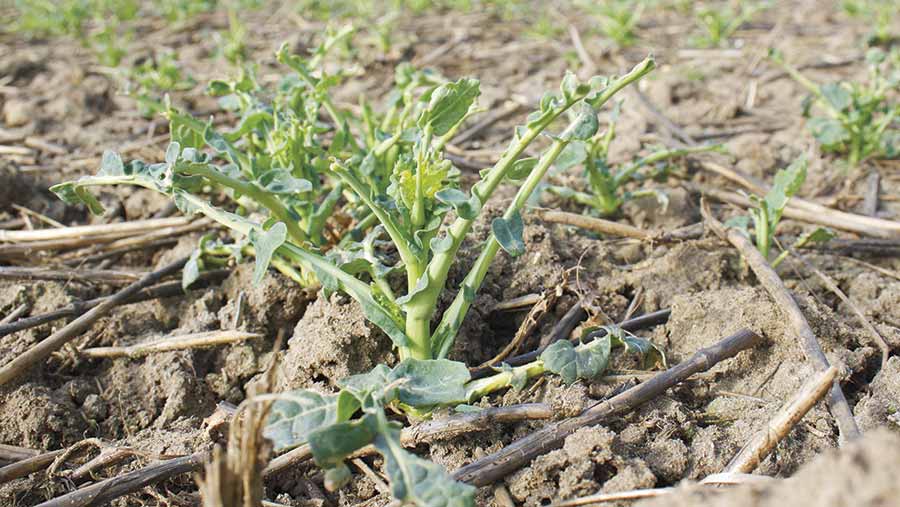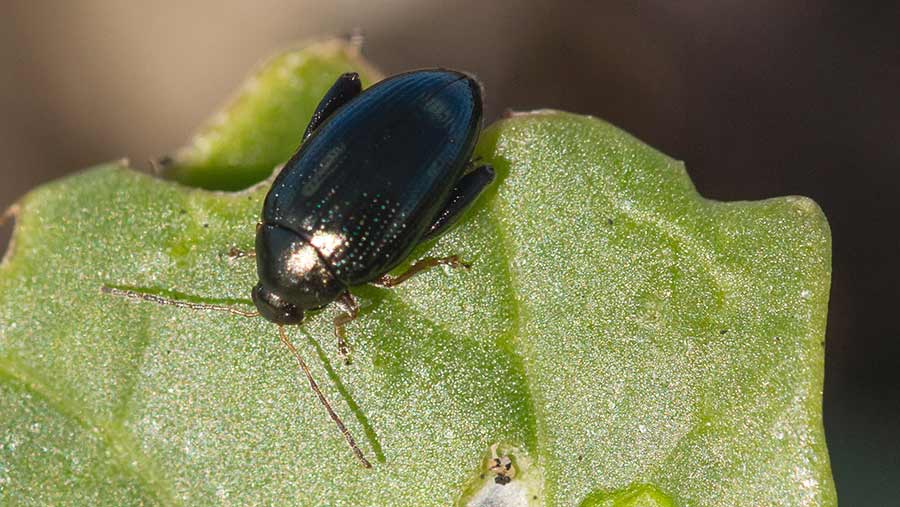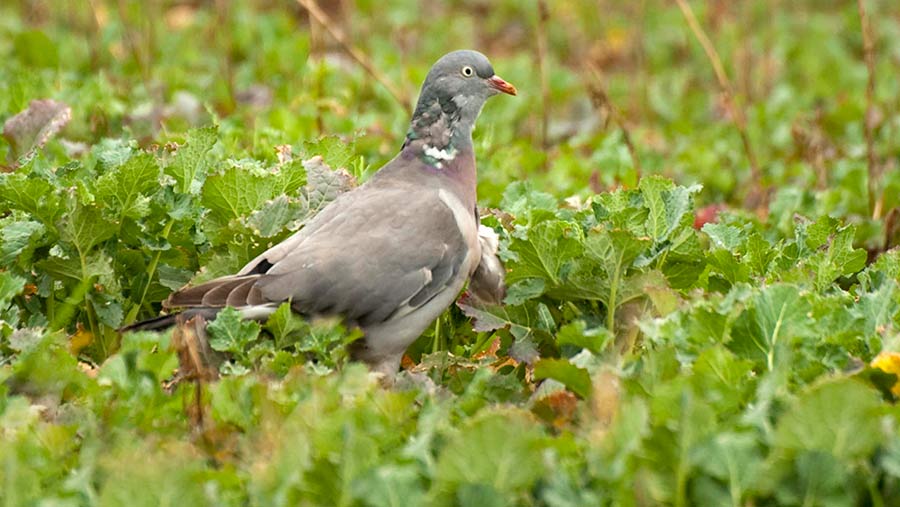Top tips on tackling pests when establishing OSR
 © FLPA/REX/Shutterstock
© FLPA/REX/Shutterstock Pests are particularly troublesome during establishment, as small oilseed rape plants are very vulnerable to attack and severe infestations can wipe out parts of a field.
All too often, oilseed rape is emerging in dry conditions, which slows growth and gives pests more time to inflict feeding damage.
An integrated approach to pest control, using more than one technique, is the best way to minimise attacks and ensure crops survive the early onslaught.
Neonicotinoid-treated seed cannot be planted, following the EU’s ban on such products on all outdoor crops.
See also: Oilseed rape variety proves its worth in charlock-infested field
1. Slugs

© Jon Rowley/SWNS
Germinating oilseed rape is extremely vulnerable to feeding by slugs, with the grey field slug being the most common problem.
The most damage is done to seedlings, as the growing point of a germinating oilseed rape shoot is above the ground. Plants remain susceptible right up until the four-true-leaf stage.
As a result, oilseed rape crops should be monitored regularly for slug damage. Estimating the size of the slug population present should be done in the field with refuge traps, placed before cultivation when the soil surface is damp.
These traps should form a cover of about 25cm in diameter, with a small amount of bait (such as chicken layers’ mash) underneath each one.
Nine traps should be set out in a W shape across each field where it is less than 20ha – increasing to 13 on the biggest fields.
Traps should be left overnight and examined early the following morning, before it warms up. If no slugs are found, trapping should continue until crops are beyond the vulnerable stage. If there are four slugs per trap, there is a risk to the following oilseed rape crop.
Risk factors
- Moisture and temperature – the activity, survival and reproduction of slugs are dependent on temperature, moisture, light and soil structure. Slugs are active between 5-20C.
- Soil type – slugs are more abundant in heavy soils
- Previous cropping – slug damage is greater after leafy crops, where soil conditions are moist.
- Crop residues – crop residues and farmyard manure applications provide slugs with a source of food and shelter.
- Cultivations – open cloddy seed-beds allow slugs easy movement and provide more shelter. Direct and delayed drilling often increase the risk of slug damage.
Cultural control
Seed-bed preparation and quality has an important role to play in the control of slugs.
Cultivations will increase slug mortality, while firm seed-beds reduce the pest’s activity by making it harder for them to move around.
A fine, consolidated seed-bed is essential for the protection of seedlings. It enables the seeds to germinate quickly and the plants to grow rapidly through the vulnerable establishment stage.
Chemical control
Applications of slug pellets are used to control slugs. These should always be used in conjunction with cultural control methods.
Pellets have to be ingested by slugs to cause death, so their palatability and durability in field conditions matter. Large slugs need to ingest more of the active substance than smaller ones.
Broadcasting is the best method of pellet application, especially when it is used in combination with fine, firm seed-beds. This action should be done as soon as possible after drilling. Pellets mixed with seed at drilling are less effective in fine seed-beds because they are not available to the slugs.
There are two active ingredients used in the manufacture of slug pellets:
- Metaldehyde – a selective molluscicide which acts on slugs by inducing excessive secretion of mucus. Metaldehyde pellets are subject to best practice restrictions and guidelines, as the active ingredient is often detected in water above EU standards. For more information on the latest guidance, visit www.getpelletwise.co.uk.
- Ferric phosphate – an alternative to metaldehyde with no restrictions on its use, ferric phosphate can also be used in organic production. Once eaten. slugs quickly stop feeding and die within three to six days, often going underground.
As a result, the effectiveness of treatment should be measured by the decrease in feeding damage, rather than by counting dead slugs.
2. Cabbage stem flea beetle
Cabbage stem flea beetle is widespread in the UK. The adult beetles are about 5mm long, shiny black in colour with a hint of green/blue.
These beetles migrate into crops during emergence and feed on the growing point, often destroying the plant.

© Blackthorn Arable
They then bite “shotholes” in the cotyledons and early true leaves. Eggs are laid at the base of plants in the soil, with newly hatched larvae boring into the leaf petioles and later into the main stems.
Risk factors
- Air temperatures above 16C are favourable for adult beetle migration, so a warm autumn will favour egg laying and early hatch.
- Slow growing crops, due to a lack of soil moisture or a cloddy seed-bed, will be less vigorous and are more prone to being eaten.
Monitoring
The numbers of adult beetles emerging from the soil in the summer can be monitored to assess the risk.
Checking beetle numbers in the previous crop’s harvested seed, looking for signs of damage to volunteer oilseed rape plants and using water traps to check for numbers of active beetles are all effective.
Without neonicotinoid seed treatments, the only control option for growers is the use of pyrethroid sprays. However, resistance to the pyrethroids in flea beetles has been confirmed, so they often provide little or no control.
Where they are to be used, pyrethroid sprays should only be applied where there is evidence of high pest pressure or if thresholds are exceeded.
Where adults have eaten over 25% of leaf area at the cotyledon-two leaf stage or over 50% of leaf area at the three-to-four true leaf stage should sprays be used at full recommended rates.
3. Pigeons
Pigeons can appear all year in large flocks, posing a particular problem in the winter.
Pigeons graze on developing oilseed rape crops and will often strip leaves right down to the main veins. Where meristems are damaged, the plant compensates by producing additional lateral shoots from the base.
Damage can be uneven across a crop, causing patchy spring development and inconsistent plant height and maturity.

FLPA/REX/Shutterstock
The best form of control is a well-established, vigorous crop, which limits their ability to land and feed. If crop establishment is patchy, a combination of shooting and the use of bird scarers can be used to reduce feeding.
4. Other Pests
Peach-potato aphid, or Myzus persicae, is the main vector of turnip yellows virus, which can decrease yields by 30%.
Aphids arriving in oilseed rape crops in the autumn transmit the virus, so a well-timed spray can be used to control them.
There are recommended varieties with resistance to turnip yellows virus, so these can be grown where high levels infection are expected.
Leaf miners can infest the first developing true leaves, causing unsightly mines. They do not justify insecticide treatment.

© Blackthorn Arable
Rape winter stem weevil adults lay their eggs on petioles close to the stem, with the larvae then feeding within the stems over the winter. There are no thresholds for this pest, which only affects local areas.
The role of companion crops in pest control?
There’s plenty of anecdotal evidence to suggest that companion crops have a role in keeping pest numbers down and reducing the need for insecticides.
Whether that’s due to a dilution effect, or that they confuse pests, remains to be seen. They may also have a barrier effect, preventing pests from getting to emerging rape plants – such as limiting the landing sites for pigeons.
Under severe pest pressure, they are unlikely to be a total solution. But for a very low cost and minimal effort, they are already providing benefits on many farms.

